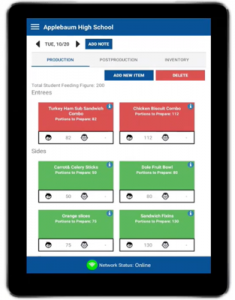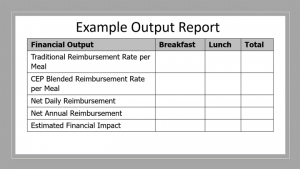Less Red Tape, Faster Lines, and Higher Participation Under CEP Can Result in Higher Net Revenue Under Blended Reimbursement Rates
When USDA offered waivers in response to COVID-19, many schools were able to offer free meals to all students for the first time. In most cases there was a dramatic increase in participation among students once they returned to school.
With waivers no longer in place, Operators are encouraged to take a look at the Community Eligibility Program (CEP). Based on demographic studies, tens of thousands of schools would qualify on an individual school basis, many on a district wide basis.
inTEAM offers a streamlined meal counting process where individual students need not be identified at point of sale, by far the largest obstacle to serving students more quickly. Our four step solution is described below side by side with USDA Guidance. We have also created a CEP calculator as a tool to predict fiscal outcomes.

inTEAM’s 4 Step Method to Accurately Count Reimbursable Meals Under CEP
- Training point of sale supervisors on compliance issues using pre and post-test pass fail criteria for its related eLearning courses.
- inTEAM further relies on a simple tablet device to track pre-and post-production requiring a review of each item and line by line entry of a la carte sales, leftover, and waste for all reimbursable meal components.
- The tablet has built in error checks to assure that (in the aggregate) minimums were met for serving adequate quantities of components to eligible students.
- Serve any la carte and other non-reimbursable teacher and staff meals at a separate pickup station. To eliminate waste and offer premium items, consider using Choosi for advance prepaid orders before serving time.

Estimate the Fiscal Impact of the CEP Counting Method for Your Program
Simply complete a short form providing the key numbers needed and we will calculate the estimated the fiscal impact of moving to inTEAM’s streamlined Meal Counting & Claiming methods. Our calculations are based on daily averages from historical experience before and during COVID when many operators disabled POS systems that required individual student accountability under USDA waiver authority.
We will estimate daily and annual revenue by comparing standard reimbursements with CEP reimbursement for both meal counting options. The fundamental assumption is that faster service will increase participation and incremental revenue, off-setting the lower reimbursement rate under CEP. We will contact you to walk through our calculations and make any needed adjustments.
USDA Guidance for streamlined Meal Counting methods under CEP
DATE: September 9, 2016 MEMO CODE: SP 54-2016 SUBJECT: Community Eligibility Provision: Guidance and Updated Q&As
“CEP [and recent temporary waivers] allows participating LEAs and schools to serve breakfast and lunch at no cost to all enrolled students without the burden of collecting household applications. By eliminating the household application process and streamlining meal counting and claiming procedures, CEP may substantially reduce administrative burden related to operating the National School Lunch Program (NSLP) and School Breakfast Program (SBP). Additionally, CEP may increase student participation, creating more opportunities for students to receive nutrition necessary to optimize academic performance. CEP may be implemented in individual schools, groups of schools, or entire school districts.”
Specific requirements for the point of service or (POS) system employed by CEP schools during meal service
Consistent with the Federal regulations at 7 CFR parts 210.7(c) and 220.11, any institution participating in the Federal school meal programs is required to take an accurate count of reimbursable meals served to students at each meal service. Serving lines must be adequately supervised to ensure that all meals claimed for SP 54-2016 September 9, 2016 Page 18 reimbursement meet meal pattern requirements, and that reimbursement meet meal pattern requirements, and that reimbursement is only claimed for one meal per student per meal service (with the exception of second breakfasts permitted to be claimed as specified in 7 CFR 220.9(a)). An accurate meal count may be achieved through a variety of methods. USDA does not require the use of any specific POS system…
